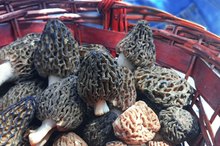Symptoms of a Mushroom Allergy
Mushrooms are a versatile and tasty addition to the diet, whether accenting foods or taking center stage at a meal. While many people enjoy mushrooms, this fungi can cause allergic reactions in a small percentage of connoisseurs. Symptoms may arise from eating, inhaling or simply having skin contact with mushrooms. If you have a mushroom allergy, inform your doctor so you can understand how to prevent and treat reactions.
Mushroom Allergies
There are at least 140,000 species of mushrooms in the world, and a majority of these have not yet been the subject of allergy research. As a result, the full spectrum of mushroom allergy symptoms is not yet known. However, mushroom allergies are considered rare -- and unique because this fungi can invoke symptoms not only from ingestion, but as a result of skin contact or from inhalation of airborne spores, which are like microscopic seeds. A mushroom allergy is not the same as mushroom poisoning, which can be a fatal response to the toxins in poisonous mushrooms.
Respiratory Symptoms
Allergy to Pumpkin
Learn More
When tiny, airborne mushroom spores are inhaled, an allergic response that affects the respiratory system can follow. The related symptoms may include sneezing, coughing, runny nose, sinus congestion, along with itching of the eyes, ears, mouth and throat. These reactions are like seasonal allergy symptoms, and can be particularly bothersome when mold counts are high. Respiratory allergy to mushroom spores has also been noted in workers who select, pack and prepare mushrooms, causing asthma symptoms including difficulty breathing, wheezing and coughing.
Skin Symptoms
Food allergies can trigger hives, which are red, swollen, and itchy areas on the skin, and a dry, itchy rash. Due to limited published research on mushroom allergy symptoms, the frequency of hives is not known. However, case reports of contact dermatitis, a skin rash that causes swelling, itching and redness of the affected skin, have been described. One report linked occupational handling of shiitake mushrooms to allergic contact dermatitis, a skin rash caused by contact with an allergen. Another report linked cases of contact dermatitis to several different mushroom species. Shiitake dermatitis is another skin reaction to raw or undercooked shiitake mushrooms, although this dermatitis is caused by the toxin lentinan, which is inactivated by cooking, and not by an allergy.
Mouth and Throat Symptoms
Symptoms of a Crab Allergy
Learn More
Oral allergy syndrome (OAS) occurs when people with allergies to pollen, for example, have an allergic response to similar proteins found in certain raw fruits and vegetables. OAS from eating mushrooms has also been documented. Typical OAS symptoms include swelling or itchiness of the mouth, face, lip, tongue and a scratchy throat. These symptoms start within an hour of eating the fruit or vegetable and usually resolve within 30 minutes.
- Oral allergy syndrome (OAS) occurs when people with allergies to pollen, for example, have an allergic response to similar proteins found in certain raw fruits and vegetables.
- These symptoms start within an hour of eating the fruit or vegetable and usually resolve within 30 minutes.
Severe Reactions After Eating
Rarely, severe allergic reactions occur after eating mushrooms. These allergies have been seen in people with previously known respiratory allergies to mold or OAS from mushrooms, but severe reactions can also occur in people who have not had a prior allergic response to mushrooms. In addition to respiratory and skin symptoms, food allergies can lead to nausea, stomach pain, vomiting and diarrhea. However, because mushroom allergies are rare, the full range of gastrointestinal symptoms from ingestion is not known.
The most severe consequence of food allergies -- anaphylaxis -- can occur after eating mushrooms. This life-threatening reaction, which warrants immediate medical attention, causes a drop in blood pressure, a weak pulse, trouble swallowing or breathing, lightheadedness, turning blue or fainting, and can swiftly progress to respiratory and cardiovascular failure -- and can cause death.
- Rarely, severe allergic reactions, but severe reactions can also occur in people who have not had a prior allergic response to mushrooms.
- The most severe consequence of food allergies -- anaphylaxis -- can occur after eating mushrooms.
Warnings
Tell your doctor if you have respiratory, skin or gastrointestinal symptoms after eating mushrooms. If you do have an allergy to mushrooms, it's important to have a treatment plan which may include carrying a medicine called epinephrine, which is used to treat anaphylatic reactions. It's also essential to understand the foods and ingredients you need to avoid, so reading food labels is important before you consume any processed foods. If you have any symptoms of anaphylaxis, use your epinephrine according to your doctor's plan, and seek immediate medical attention.
Reviewed by Kay Peck, MPH RD
- Tell your doctor if you have respiratory, skin or gastrointestinal symptoms after eating mushrooms.
- If you do have an allergy to mushrooms, it's important to have a treatment plan which may include carrying a medicine called epinephrine, which is used to treat anaphylatic reactions.
Related Articles
References
- Pediatric Allergy, Immunology and Pulmonology: Cross-Reactivity Between Molds and Mushrooms
- American Journal of Respiratory and Critical Care Medicine: Protein Identification of Two Allergens of Boletus edulis Causing Occupational Asthma
- ActaDV: Rare Ingestive Food Allergy to Mushroom Boletus badius
- Annals of Asthma, Allergy and Immunology: Cross-Reactivity Between Raw Mushroom and Molds in a Patient With Oral Allergy Syndrome.
- American College of Allergy, Asthma & Immunology: Oral Allergy Syndrome
- American Academy of Dermatology: Contact Dermatitis
- The Australasian Journal of Dermatology: Contact Dermatitis to Shiitake Mushroom.
- Mycopathologia: Allergic Contact Dermatitis Caused by Mushrooms. A Case Report and Literature Review.
- American Journal of Clinical Dermatology: Shiitake Mushroom Dermatitis: A Review.
- Allergology International: Anaphylaxis Caused by the Ingestion of Cultivated Mushroom (Agaricus Bisporus): Identification of Allergen as Mannitol
- Fun with funghi: Garnish your meals with mushrooms. Academy of Nutrition and Dietetics. Updated January 17, 2019.
- Mushrooms, raw. FoodData Central. U.S. Department of Agriculture. Published April 1, 2019.
- Nakashima A, Yamada K, Iwata O, et al. β-Glucan in foods and its physiological functions. J Nutr Sci Vitaminol. 2018;64(1):8-17. doi:10.3177/jnsv.64.8
- Lo HC, Wasser SP. Medicinal mushrooms for glycemic control in diabetes mellitus: History, current status, future perspectives, and unsolved problems (review). Int J Med Mushrooms. 2011;13(5):401-26. doi:10.1615/IntJMedMushr.v13.i5.10
- Institute of Medicine (US) Panel on Micronutrients. Dietary Reference Intakes for vitamin A, vitamin K, arsenic, boron, chromium, copper, iodine, iron, manganese, molybdenum, nickel, silicon, vanadium, and zinc. Washington (DC): National Academies Press (US); 2001.
- Potassium. Fact Sheet for Professionals. National Institutes of Health Office of Dietary Supplements. Updated March 2, 2020
- Iron. Fact Sheet for Professionals. National Institutes of Health Office of Dietary Supplements. Updated December 19, 2019
- Wasser SP. Medicinal mushroom science: History, current status, future trends, and unsolved problems. Int J Med Mushrooms. 2010;12(1):1-16. doi:10.1615/IntJMedMushr.v12.i1.10
- Chaturvedi VK, Agarwal S, Gupta KK, Ramteke PW, Singh MP. Medicinal mushroom: Boon for therapeutic applications. 3 Biotech. 2018;8(8):334. doi:10.1007/s13205-018-1358-0
- Cheung PCK. The nutritional and health benefits of mushrooms. Nutr Bull. 2010;35(4):292-299. doi:10.1111/j.1467-3010.2010.01859.x
- Kalaras MD, Richie JP, Calcagnotto A, Beelman RB. Mushrooms: A rich source of the antioxidants ergothioneine and glutathione. Food Chem. 2017;233:429-433. doi:10.1016/j.foodchem.2017.04.109
- Feng L, Cheah IK, Ng MM, et al. The association between mushroom consumption and mild cognitive impairment: A community-based cross-sectional study in Singapore. J Alzheimers Dis. 2019;68(1):197-203. doi:10.3233/jad-180959
- Vitamin D. Fact Sheet for Professionals. National Institutes of Health Office of Dietary Supplements. Updated March 24, 2020
- Keegan RJ, Lu Z, Bogusz JM, Williams JE, Holick MF. Photobiology of vitamin D in mushrooms and its bioavailability in humans. Dermatoendocrinol. 2013;5(1):165-76. doi:10.4161/derm.23321
- McRae MP. Dietary fiber intake and type 2 diabetes mellitus: An umbrella review of meta-analyses. J Chiropr Med. 2018;17(1):44-53. doi:10.1016/j.jcm.2017.11.002
- Ferreira H, Alves M, Pineda F et al. Cross-reactivity between molds and mushrooms. Pediatr Allergy Immunol and Pulmonol. 2017;30(2):126-128. doi:10.1089/ped.2017.0746
- North American Mycological Association. Mushroom poisoning syndromes.
- Nardozzi, C. The National Gardening Association. Learning Library. Edible Landscaping - Edible of the Month: Two Simple, Beginner Mushrooms.
- Mushrooms, canned. FoodData Central. U.S. Department of Agriculture. Published April 1, 2019.
Resources
Writer Bio
Nancy Clarke began writing in 1988 after achieving her Bachelor of Arts in English and has edited books on medicine, diet, senior care and other health topics. Her related affiliations include work for the American Medical Association and Oregon Health Plan.









